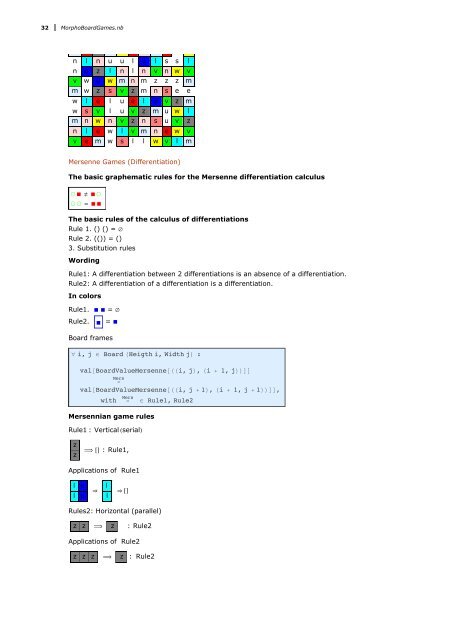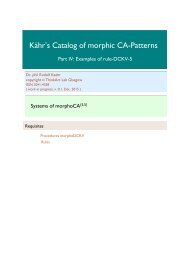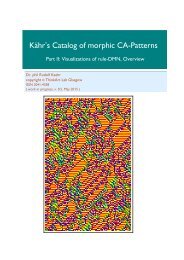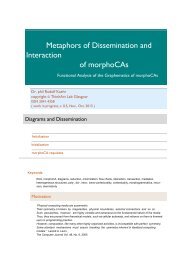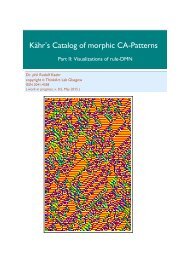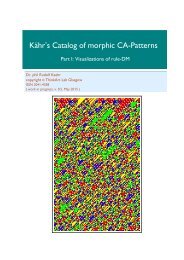Towards a new Paradigm of Board Games
"There is no reason that forces the game industry to restrict itself on a paradigm of games that is repetitive, addictive, regressive and is denying the right of the user to develop his/hers intellectual capabilities of creativity. It is a strategic decision of the game industry to stupidify its costumers." ThinkArt Lab To introduce the paradigm of morphic (board) games, I start with two simple questions. Why are classical games producing regressive addiction and boredom? What are the differences between classical and morphic games? My first answers to the questions might be summarized as follows: Classical games are based on the perceptive acts of identification and separation of the elements of the game by the rules of the game. Morphic Games are involved into differentiations and structurations of interactive and reflectional patterns (morphograms) in complex constellations. For a more conceptual answer of the two questions I connect the proposed new kind of games to the theory and practice of morphogrammatics. What do I understand by morphogrammatics? Morphogrammaitics is a pre-semiotic theory of inscription. It is studying and formalizing the 'deep-structure' of semiotics. Mathematically, morphograms, as the fundamential patterns of morphogrammatics, are representations of Stirling numbers of the second kind. Formal semiotics consists of an sign repertoire and rules of maipulating its signs. This is established by a strict difference of operators and oprands (signs). In contrast, morphograms are playing a double role: they are involved in a chiastic interplay of patterns (operands) and rules (operators). This is in decisive conterast to identity-based semiotic systems that are based on atomic signs. Strings of signs are based on a set of signs with cardinality m and its potentiation (n): m^n. Hence for m=4 and n=4, there are exactly 4^4 = 256 different semiotic strings possible. But on a morphogrammatical level there are just exactly Sn(4,4) = 1+6+7+1=15 morphograms for m=n=4 possible. In this sense, those 15 morphograms are presenting the 'deep-structure' of the set of semiotic strings of length 4.
"There is no reason that forces the game industry to restrict itself on a paradigm of games that is repetitive, addictive, regressive and is denying the right of the user to develop his/hers intellectual capabilities of creativity.
It is a strategic decision of the game industry to stupidify its costumers." ThinkArt Lab
To introduce the paradigm of morphic (board) games, I start with two simple questions.
Why are classical games producing regressive addiction and boredom?
What are the differences between classical and morphic games?
My first answers to the questions might be summarized as follows:
Classical games are based on the perceptive acts of identification and separation of the elements of the game by the rules of the game.
Morphic Games are involved into differentiations and structurations of interactive and reflectional patterns (morphograms) in complex constellations.
For a more conceptual answer of the two questions I connect the proposed new kind of games to the theory and practice of morphogrammatics.
What do I understand by morphogrammatics?
Morphogrammaitics is a pre-semiotic theory of inscription. It is studying and formalizing the 'deep-structure' of semiotics.
Mathematically, morphograms, as the fundamential patterns of morphogrammatics, are representations of Stirling numbers of the second kind.
Formal semiotics consists of an sign repertoire and rules of maipulating its signs. This is established by a strict difference of operators and oprands (signs).
In contrast, morphograms are playing a double role: they are involved in a chiastic interplay of patterns (operands) and rules (operators).
This is in decisive conterast to identity-based semiotic systems that are based on atomic signs. Strings of signs are based on a set of signs with cardinality m and its potentiation (n): m^n. Hence for m=4 and n=4, there are exactly 4^4 = 256 different semiotic strings possible.
But on a morphogrammatical level there are just exactly Sn(4,4) = 1+6+7+1=15 morphograms for m=n=4 possible. In this sense, those 15 morphograms are presenting the 'deep-structure' of the set of semiotic strings of length 4.
Create successful ePaper yourself
Turn your PDF publications into a flip-book with our unique Google optimized e-Paper software.
32 Morpho<strong>Board</strong><strong>Games</strong>.nb<br />
n l n u u l u l s s l<br />
n u z l n l n v n w v<br />
v w u w m n m z z z m<br />
m w z s v z m n s e e<br />
w l e l u e l u v z m<br />
w s v l u v z m u w l<br />
m n w n v z n s u v z<br />
n l e w l v m n e w v<br />
v e m w s l l w v l m<br />
Mersenne <strong>Games</strong> (Differentiation)<br />
The basic graphematic rules for the Mersenne differentiation calculus<br />
Á ‡ ¹≠ ‡ Á<br />
Á Á = ‡ ‡<br />
The basic rules <strong>of</strong> the calculus <strong>of</strong> differentiations<br />
Rule 1. () () = Ø<br />
Rule 2. (()) = ()<br />
3. Substitution rules<br />
Wording<br />
Rule1: A differentiation between 2 differentiations is an absence <strong>of</strong> a differentiation.<br />
Rule2: A differentiation <strong>of</strong> a differentiation is a differentiation.<br />
In colors<br />
Rule1. ‡ ‡ = Ø<br />
Rule2. ‡ = ‡<br />
<strong>Board</strong> frames<br />
" i, j œ <strong>Board</strong> HHeigth i, Width jL :<br />
val@<strong>Board</strong>ValueMersenne@HHi, jL, Hi + 1, jLLDD<br />
Mers<br />
=<br />
val@<strong>Board</strong>ValueMersenne@HHi, j + 1L, Hi + 1, j + 1LLDD,<br />
with Mers = œ Rule1, Rule2<br />
Mersennian game rules<br />
Rule1 : Vertical HserialL<br />
z<br />
z<br />
ï @D : Rule1,<br />
Applications <strong>of</strong> Rule1<br />
l<br />
u<br />
l u fl l l<br />
fl @D<br />
Rules2: Horizontal (parallel)<br />
z z ï z : Rule2<br />
Applications <strong>of</strong> Rule2<br />
z z z ï z : Rule2


